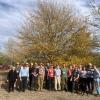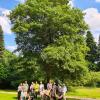Editor's Picks
Plant Focus
Poster presented at the XX International Botanical Conference, Madrid, Spain, July 21–27, 2024.
Authors:
D. Fantozzi1, D. Trupiano1, G.S. Scippa1, G. Sferra1
Affiliations:
1. University of Molise, Campobasso, Italy
Abstract:
In an increasingly urbanised world, the importance of oak trees in urban environments is growing. Although oaks continue to provide ecological, aesthetic, and social benefits in cities, they face unique challenges due to urban environmental stressors, such as limited root space and poor-quality soils. Therefore, it is essential to understand the adaptability and resilience of oak roots since they play a crucial role in the survival trends and health states of these urban plants. Roots are crucial in resisting adverse environmental conditions since they absorb nutrients and water, as well function in tree anchoring especially in often altered urban soils. However, studying roots in urban environment represents a significant challenge due to their underground nature, which, in urban contexts, is furtherly complicated by the complexity of this environment. So, molecular techniques, such as DNA barcoding, provide new opportunities to distinguish tree species and to explore the biological diversity associated with their roots. Thus, the purpose of this study, funded by “National Biodiversity Future Center—NBFC" project (CUP: H73C22000300001) under the National Recovery and Resilience Plan (NRRP) —NextGenerationEU, Mission 4 Component 2 Investment 1.4, is to apply DNA barcoding to identify oak species and related abiotic and biotic interactors in urban contexts. In this perspective here we propose the design of PCR primers for species-specific DNA barcoding of Quercus cerris. The approach was based on: target sequence identification (scientific literature and sequence databases) and selection known sequences among oak genus with the highest genetic divergence, primer design and testing. Several primer pairs have been identified with the potential to distinguish Q. cerris from other species of the same genus and have been in silico validated. The upcoming phase includes the testing of these primers by known samples to confirm their specificity to Q. cerris and subsequently applying them to field samples.
















